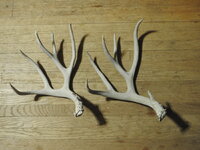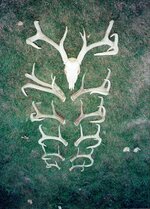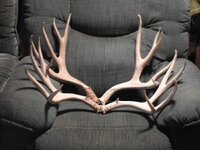littlebigtine
WKR
- Joined
- Apr 3, 2021
- Messages
- 577
Ill leave this here
Follow along with the video below to see how to install our site as a web app on your home screen.
Note: This feature may not be available in some browsers.
I can agree with everything you have written down but bucks at there biggest at 3 or 4. I have found little evidence of this. Some bucks will be big at age 3, they will be bigger at age 7 or 8 barring some disease or catastrophic weather event.A lot of bucks will be their biggest at 3 or 4 years.
Given consistent feed and weather conditions they will probably peak older but we all know that weather and range conditions change a lot. If 3 or 4 is when they have the best conditions then that could be their biggest year. Mass will always go up but length may not. Being biggest at 3 or 4 is definitely not the norm but entirely possible and somewhat common, especially 4 as 4 will be very close to the peak anyways given constant range conditions.I can agree with everything you have written down but bucks at there biggest at 3 or 4. I have found little evidence of this. Some bucks will be big at age 3, they will be bigger at age 7 or 8 barring some disease or catastrophic weather event.
Fair points. But wouldn't it also be effective to institute minimum point restrictions? A lot of 1-2 year old forkies and barely legal bucks get shot in the early seasons. I'd argue the ratio for my units are in the 5-15:100 range without looking up stats just based on anecdotal observations this year. CPW says its 23. I have found a lot of those bucks are forkies and barely legal spikes. Huge lack in older aged bucks.I do pass on lots of deer thanks. I just don't thump my chest all over social media telling everyone about the deer I passed on and how I'm better than them because of it. I just shoot deer that make me happy when the science says it supports it.
The tricky bit is that actually shooting bucks creates more deer. More deer creates more potential bucks. You don't want to have 50 bucks per 100 does or the does and the fawns will be pushed off feed. If you keep your buck numbers below 20:100 you can have a lot more does on the landscape which can in turn create a lot more deer. Even the most heavily hunted OTC units can and do turn out huge bucks.
I'd love to see 190" deer behind every tree as much as anyone and if there was evidence that supported a way to create that then I would be for it. I think that closing some units to mature deer for a couple years on a rotating schedule would be awesome. Issue a controlled number of tags to let people shoot some of the smaller bucks but 4 points are off limits for 2 or 3 years then open the unit back up. You should still have healthy buck to doe ratios and a lot of really nice deer. If you do it right I think you could ull it off without having a missing age class but that would be a risk if not well managed. If yo really want to see a successful deer program and see places turning out big bucks consistently it would take careful management like this. Like I said before, asking people not to shoot small bucks will never work at scale because for a lot of people a 150-160" deer is an absolute giant and they would never pass on it.
The other tricky bit on passing smaller bucks (150") is a lot of deer will never get much bigger than that or the "small 4 point" you just passed on is actually a 7 year old deer. A lot of bucks will be their biggest at 3 or 4 years.
Every unit must be managed different to achieve its objective, unfortunately that sort of attention is not hardly every given. In the case above as you say, you would need to find a way to let some of those deer survive to maturity while still harvesting some of the small ones to keep the buck:doe ratio in balance. 5 is really low ratio and they should just close the unit for a couple years.Fair points. But wouldn't it also be effective to institute minimum point restrictions? A lot of 1-2 year old forkies and barely legal bucks get shot in the early seasons. I'd argue the ratio for my units are in the 5-15:100 range without looking up stats just based on anecdotal observations this year. CPW says its 23. I have found a lot of those bucks are forkies and barely legal spikes. Huge lack in older aged bucks.
This is the way.Want bigger bucks? Super easy.
Shut down half the roads through their habitat. Especially lower range where they rut and winter.
Food
Water
Sanctuary
Or hunters can just keep bickering with each other. That’s not getting us anywhere.
This is the way.1) HABITAT
2)WEATHER
3)PREDATION
These are in order the major influences on deer mortality. Really HABITAT and WEATHER are the same. One we have some control over. The other not so much.
You want big bucks? Focus on the number 1 determining factor: Habitat.
You think predation is the limiting factor? You dont want to shoot a dink? Thats fine but the effect isnt as directly correlated to your desired outcome as you think.
.5-2 yr old deer have a very high mortality rate but not because of hunting. Because the world is a dangerous, unforgiving thing.
I see as much roadkill on the side of my local highways as fish and game records buck harvest in my local units on an annual basis. Id guess that %75 lying in the ditch are fawns.
We are hunters so naturally you look to hunting to figure out ways to improve deer numbers but id wager that our efforts are better spent protecting wildlife corridors or replanting burns on winter range.
Conservation is way more than not pulling a trigger
Maybe it is different where you live, but I have watched or found sheds from dozens of bucks that have lived to old age, I have never seen one that grew his best set of antlers at age four. Some of those bucks were big at a young age, but they were better a few years later. I have seen studies that indicate bucks have nearly reached there potential at age four, but the problem with these studies is that they rely on B&C gross score. B&C scoring is the best system available, but it relies heavily on tine length and when you combine this with NT points the results can be miss leading. This buck is a good example. The buck was at least four when he grew the smaller antler and two years older when he grew the bigger antler. The smaller antler is an 81 inch four point with a 6 3/8 inch inline. The bigger antler is nearly 85 on the frame with a 7 inch inline. Not a huge percentage difference score wise, but the bigger antler weighs 30% more and when you hold them there is no doubt that the bigger antler is much bigger. I have three more singles from this side of the buck, all bigger than the smaller antler but some do not score as much because of less NT.Given consistent feed and weather conditions they will probably peak older but we all know that weather and range conditions change a lot. If 3 or 4 is when they have the best conditions then that could be their biggest year. Mass will always go up but length may not. Being biggest at 3 or 4 is definitely not the norm but entirely possible and somewhat common, especially 4 as 4 will be very close to the peak anyways given constant range conditions.

I think you experience is aligned to what I said about score not really changing but mass will. Yeah in the desert I'd say you have bigger fluctuations year to year than in MT.Maybe it is different where you live, but I have watched or found sheds from dozens of bucks that have lived to old age, I have never seen one that grew his best set of antlers at age four. Some of those bucks were big at a young age, but they were better a few years later. I have seen studies that indicate bucks have nearly reached there potential at age four, but the problem with these studies is that they rely on B&C gross score. B&C scoring is the best system available, but it relies heavily on tine length and when you combine this with NT points the results can be miss leading. This buck is a good example. The buck was at least four when he grew the smaller antler and two years older when he grew the bigger antler. The smaller antler is an 81 inch four point with a 6 3/8 inch inline. The bigger antler is nearly 85 on the frame with a 7 inch inline. Not a huge percentage difference score wise, but the bigger antler weighs 30% more and when you hold them there is no doubt that the bigger antler is much bigger. I have three more singles from this side of the buck, all bigger than the smaller antler but some do not score as much because of less NT.View attachment 793910
How do you know the age of these bucks?Maybe it is different where you live, but I have watched or found sheds from dozens of bucks that have lived to old age, I have never seen one that grew his best set of antlers at age four. Some of those bucks were big at a young age, but they were better a few years later. I have seen studies that indicate bucks have nearly reached there potential at age four, but the problem with these studies is that they rely on B&C gross score. B&C scoring is the best system available, but it relies heavily on tine length and when you combine this with NT points the results can be miss leading. This buck is a good example. The buck was at least four when he grew the smaller antler and two years older when he grew the bigger antler. The smaller antler is an 81 inch four point with a 6 3/8 inch inline. The bigger antler is nearly 85 on the frame with a 7 inch inline. Not a huge percentage difference score wise, but the bigger antler weighs 30% more and when you hold them there is no doubt that the bigger antler is much bigger. I have three more singles from this side of the buck, all bigger than the smaller antler but some do not score as much because of less NT.View attachment 793910
I don't for sure, but when you find enough antlers form the deer or watch them from a very young age you can get a good idea. For example on the buck I posted I have the opposite side from the year earlier than the smaller antler in the picture. Confident that he was not a 180 class NT as a two year old, possible that he could have been as a three year old so that would make him at least four when he grew the smaller antler but he easily could have been older.How do you know the age of these bucks?
 I found every antler he grew. At age four he was a mid to upper 150's four point. At age 6 when he died of EHD he was a three by four typical with two NT points on the four point side that gross scores close to 180
I found every antler he grew. At age four he was a mid to upper 150's four point. At age 6 when he died of EHD he was a three by four typical with two NT points on the four point side that gross scores close to 180My buddy shot a 200" NT in Eastern MT a couple years ago that was aged at 4.5 yrs old. They found one of his white sheds (hard white) the same trip that would have scored in the low/mid 170s as a 2.5 yr old, which is insane (obviously there is some error in the tooth aging, maybe they missed a ring and he was 5.5). I know they also track bucks that are in the 160's or bigger as 2.5 yr olds in Region H and G in WY, as well as 3.5 yr olds well into the 180's+, so it can happen. I trust the WY stuff more because they are collaring them as fawns, so they know the exact age. Pretty crazy.I don't for sure, but when you find enough antlers form the deer or watch them from a very young age you can get a good idea. For example on the buck I posted I have the opposite side from the year earlier than the smaller antler in the picture. Confident that he was not a 180 class NT as a two year old, possible that he could have been as a three year old so that would make him at least four when he grew the smaller antler but he easily could have been older.
The whitetail was lab aged, If I was going by the antlers I found, I would have said at least seven.
It could also be that the shed was from the spring if they found the antler in the fall. I have found plenty of hard white antlers in the fall that were shed in the spring. Just depends on how much sun they get. These antlers are from a buck I shot. Found the biggest brown in the spring the match I found hunting the buck in September. I will try to get a picture with better lighting.My buddy shot a 200" NT in Eastern MT a couple years ago that was aged at 4.5 yrs old. They found one of his white sheds (hard white) the same trip that would have scored in the low/mid 170s as a 2.5 yr old, which is insane (obviously there is some error in the tooth aging, maybe they missed a ring and he was 5.5). I know they also track bucks that are in the 160's or bigger as 2.5 yr olds in Region H and G in WY, as well as 3.5 yr olds well into the 180's+, so it can happen. I trust the WY stuff more because they are collaring them as fawns, so they know the exact age. Pretty crazy.

Hobbs killed a 200 plus that was 3.5 if I remember correctly.My buddy shot a 200" NT in Eastern MT a couple years ago that was aged at 4.5 yrs old. They found one of his white sheds (hard white) the same trip that would have scored in the low/mid 170s as a 2.5 yr old, which is insane (obviously there is some error in the tooth aging, maybe they missed a ring and he was 5.5). I know they also track bucks that are in the 160's or bigger as 2.5 yr olds in Region H and G in WY, as well as 3.5 yr olds well into the 180's+, so it can happen. I trust the WY stuff more because they are collaring them as fawns, so they know the exact age. Pretty crazy.
I should have specified further and said hard white/chalk. It was definitely not a 7-8 month old antler.It could also be that the shed was from the spring if they found the antler in the fall. I have found plenty of hard white antlers in the fall that were shed in the spring. Just depends on how much sun they get. These antlers are from a buck I shot. Found the biggest brown in the spring the match I found hunting the buck in September. I will try to get a picture with better lighting. View attachment 794434
